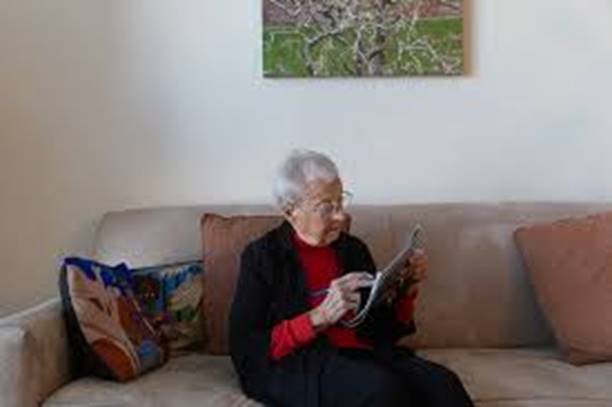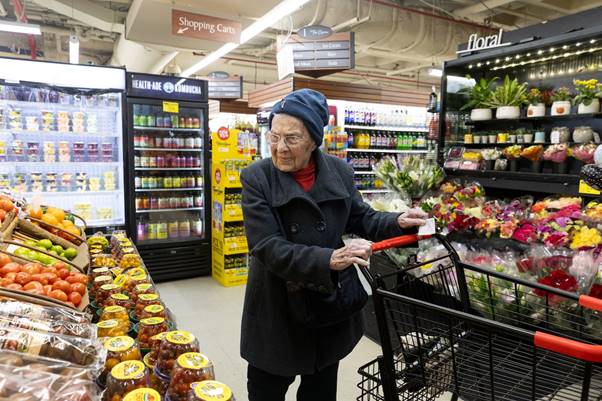
Hilda Jaffe, 102, in her apartment in New York. Jaffe enjoys doing puzzles, reading, volunteering and attending cultural events - Jackie Molloy for KFF Health News
She’s 102 Years Old, Thriving, Active, and Living Life on Her Own Terms
“The future is here,” the email announced. Hilda Jaffe, then 88, was letting her children know that she planned to sell the family home in Verona, New Jersey. She’d decided to begin life anew on her own in a one-bedroom apartment in Hell’s Kitchen in Manhattan.
Fourteen years later, Jaffe, now 102, still lives alone — just a few blocks from the frenetic lights and crowds that course through Times Square.
She’s the rarest of seniors: a centenarian who is as sharp as a tack, who carries grocery bags in each hand when she walks back from her local market, and who takes city buses to see her physicians or attend a matinee at the Metropolitan Opera.
Jaffe is an extraordinary example of an older adult living by herself and thriving. She cleans her own house, does her own laundry, manages her own finances, and stays in touch with a far-flung network of family and friends via email, WhatsApp and Zoom. Her 78-year-old son lives in San Jose. Her 75-year-old daughter lives in Tel Aviv.
I’ve spoken with dozens of seniors this past year for a series of columns on older Americans living alone. Many struggle with health issues. Many are isolated and vulnerable . But a noteworthy slice of this growing group of seniors maintains a high degree of well-being.
What might account for this, particularly among people in the farthest reaches of old age?
Sofiya Milman is the director of human longevity studies at the Institute for Aging Research at Albert Einstein College of Medicine. She studies people known as “superagers” age 95 and older. “As a group, they have a very positive outlook on life” and are notably resilient, like Jaffe, she told me.
Qualities associated with resilience in older adults include optimism, hopefulness, an ability to adapt to changing circumstances, meaningful relationships, community connections, and physical activity, according to a growing body of research on this topic.
Jaffe has those qualities in spades, along with a “can-do” attitude.
“I never expected to be 102. I’m as surprised as everybody else that I am here,” she said recently over lunch at a Chinese restaurant just steps from her 30-story apartment building.
She’s ‘pragmatic’ and keeps moving
Jaffe’s perspective on her longevity is unsentimental. She credits her genetic heritage, luck and her commitment to “keep moving,” in that order. “You don’t work toward it; it happens. Every day, you get up and you’re a day older,” she said.
This matter-of-fact stance is characteristic of Jaffe’s approach to life. Asked to describe herself, she quickly responded with “pragmatic.” That means having a clear-eyed view of what she can and can’t do and making adjustments as necessary.
Living alone suits her, she added, because she likes being independent and doing things her way. “If a problem comes up, I work it out,” Jaffe said.
In this, she’s like other older adults who have come to terms with their “I’m on my own” status and who, for the most part, are doing quite well.
Still, Jaffe is unusual, to say the least. There are only some 101,000 centenarians in the United States, according to the most recent Census Bureau data. Of this small group, 15 percent live independently or conduct their lives independently while living with someone, according to Thomas Perls, the founder and director of the New England Centenarian Study, the largest study of centenarians in the world. (Jaffe is one of about 2,500 centenarians participating in the study.)
About 20 percent of centenarians are, like Jaffe, free of physical or cognitive impairments, Perls said. An additional 15 percent have no age-related illnesses, such as arthritis or heart disease.
Practically, that means Jaffe doesn’t know anybody like her. Nor do her physicians. “My primary-care doctor says, ‘You’re the only centenarian who walks in without an assistant or a cane. You’re off the charts,’” Jaffe said.
 The Washington Post
The Washington Post
She has only a few medical conditions: reflux, an occasional irregular heartbeat, osteoporosis, a touch of sciatica, and a lung nodule that appeared and then disappeared. She monitors those conditions vigilantly, following her doctors’ advice to the letter.
Every day, Jaffe tries to walk 3,000 steps — outside if the weather is good, or inside, making laps in her hallway, if the weather is bad. Her diet is simple: bread, cheese and decaffeinated coffee for breakfast; a sandwich or eggs for lunch; often chicken and a vegetable or restaurant leftovers for dinner. She never smoked, doesn’t drink alcohol, and sleeps an average of eight hours each night.
Even more important, Jaffe remains engaged with other people. She has subscriptions to the Metropolitan Opera, the New York Philharmonic and a chamber music series. She participates in online events and regularly sees new exhibits at four of New York’s premier museums, where she has memberships. She’s in regular contact with family members and friends.
Jaffe also belongs to a book club at her synagogue on Manhattan’s Upper West Side and serves on the synagogue’s adult education committee. For more than a decade, she has volunteered several times a week as a docent at the New York Public Library’s main branch on Fifth Avenue.
“Loneliness, it’s not an issue,” she said. “I have enough to do within my capability.”
A focus on the future
On a recent Tuesday afternoon, I followed Jaffe as she led visitors from Mexico, England, Pennsylvania and New Jersey through the library’s “Treasures” exhibit. She was a wealth of information about extraordinary objects such as a Gutenberg Bible from the mid-15th century (one of the first books printed in Europe using movable type), Charles Dickens’s writing desk and an enormous folio of John James Audubon’s “The Birds of America.” She spoke fluently, without notes.
When I asked about the future, Jaffe said she doesn’t worry about what comes next. She just lives day to day.
That change in perspective is common in later life. “Focusing on the present and experiencing the here and now becomes more important to older adults,” said Laura Carstensen, founding director of the Stanford Center on Longevity, who has studied emotional changes that accompany aging for decades. “As does savoring positive things in their lives.”
Carstensen’s research group was the first to show that older adults were more resilient emotionally during the coronavirus pandemic than young or middle-aged adults. “Older people are better able to cope with difficulties,” she said. In part, this is because of skills and perspectives gained over the course of a lifetime. And, in part, it’s because “when we see our future as shorter, it feels more manageable.”
Jaffe certainly understands the value of facing forward and letting go of the past. Losing her husband, Gerald Jaffe, in 2005 after 63 years of marriage was hard, she admitted, but relinquishing her life and most of her belongings in New Jersey five years later was easy.
“It was enough. We had done what we had wanted to do there. I was 88 at that point, and so many people were gone. The world had changed,” she told me. “I didn’t feel a sense of loss.”
“It was so exciting for me, being in New York,” she continued. “Every day you could do something — or nothing. … In a house in New Jersey, I would be isolated. Here, I look out the window and I see people.”
As for the future, who knows what that will hold? “My joke is I’m going to be done in by a bicycle delivery person cutting through the pedestrian crosswalk,” Jaffe said. Until that or something else happens, “I live in a state of surprise. Every day is a new day. I don’t take it for granted at all.” – The Washington Post

